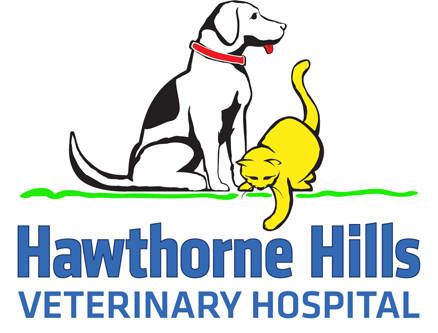
Gracie is a peppy 9-year-old Dandie Dinmont terrier who has been seen regularly by the doctors at Hawthorne Hills Veterinary Hospital. She was adopted by her owner through a rescue organization in 2010 and when Gracie first arrived in Seattle she was found to have Heartworm disease. Heartworm disease can have devastating consequences but Gracie tolerated her treatment well and has been very healthy since that time.
In late January of this year, Gracie was evaluated by Dr. Robin Riedinger during her bi-annual ‘Healthy Pet’ physical exam. As is common for many pets, Gracie had developed a moderate amount of tartar on her teeth and a dental cleaning was scheduled. Baseline blood work was obtained before planning her anesthetic procedure. It was quite surprising to find that Gracie had a significant elevation of one of her liver enzymes (ALT = 551, Normal is 5-65) and a slightly low thyroid level, all without any symptoms.
As veterinarians, we frequently find that ‘routine’ lab work isn’t routine at all. Dogs and cats are really good at hiding their symptoms; if we wait to get a proper diagnosis until they are sick, we lose valuable time in helping them get better. In addition, by the time symptoms are obvious, some diseases may have progressed beyond the point of meaningful treatment.
The liver is an amazing organ and has the ability to heal, yet there are many things that can affect the liver and cause elevations of enzymes in the blood. Finding the cause of liver disease is extremely important because not all diseases have the same treatment or the same success rate. Getting a diagnosis early can ensure that the treatment is focused on the correct issue, that it helps to maintain liver function while the body is healing, and also allows timely adjustments in the treatment plan if the patient subsequently starts having problems.
 Gracie’s owner was very concerned and wanted to pursue additional diagnostics right away.
Gracie’s owner was very concerned and wanted to pursue additional diagnostics right away.
We started by getting a urinalysis, fecal sample (looking for parasites), abdominal and chest radiographs and a full thyroid panel (to assess thyroid function). We discovered that Gracie’s thyroid function was low and she was started on thyroid supplementation. However, no other significant issues were uncovered and her liver function test (Bile Acids Panel) was normal. This just didn’t explain the dramatic increase in Gracie’s liver enzymes, so an abdominal ultrasound was scheduled to assess the liver more closely.
Radiographs are excellent for seeing changes with the size or shape of an organ, finding changes like arthritis in the joints, or discovering fluid that has accumulated where it doesn’t belong. With ultrasound we can look at the interior aspect of tissues. Think of radiographs like taking a picture of an orange – we see the outside shape and size. Think of an ultrasound as looking inside the orange to evaluate the texture, to know if each segment is normal, or determine if there an area that is rotten with dried out pulp.
Gracie’s abdominal ultrasound revealed a normal liver but a large and gelatinous filled abnormal gall bladder – a Biliary Mucocoele. Bile is made by the liver, stored in the gall bladder and released into the intestinal tract to help with digestion. The normal bile in the gall bladder should be liquid; a variety of diseases can cause it to become thicker and it can form a gelatinous gunk or become mineralized into ‘stones’. Either way, the bile doesn’t function appropriately and material can back up and affect the function of the liver.
Knowing that surgery is often required, Dr. Riedinger consulted with a local internal medicine specialist and together they planned for that possibility if it arose. Because Gracie was not showing symptoms, she was immediately started on a treatment regimen to hopefully allow her body to recover without the need for surgery:
- Ursodiol to try to soften and mobilize the bile
- Denosyl (SAMe) for oxidative support for the liver tissue
- Metronidazole and Enrofloxacin to treat any potential infection
- A low fat diet which several studies have shown can help
- Cerenia for any nausea if it developed
- and we continued her Levothyroxine for hypothyroidism
Unfortunately, about 3 weeks after initiating treatment, Gracie started having symptoms – vomiting, not wanting to eat, and not feeling well. She was seen at Hawthorne Hills, started on supportive care of IV fluids and additional anti-nausea and pain medications. A repeat of the blood work showed that her liver enzyme (ALT) had increased to 2961, remember that normal is 5-65. This indicated that her liver was in danger of failing and surgery was now essential.
With the prior diagnostics and a clear picture of what was causing Gracie’s illness, it made the next steps less traumatic for the owner and for Gracie. We knew what her medical problem was, we knew what her treatment plan needed to be, and the specialists were already in the loop. Gracie was admitted that day to one of our local 24/7 emergency facilities to have her gall bladder surgically removed.
Dogs and people can live without a gall bladder, and Gracie will continue to be monitored for some time. However, her prognosis is excellent, and we are happy to report that Gracie made a full recovery and is now back to enjoying her life.
Here is a link with additional information:
http://www.veterinarypartner.com/Content.plx?P=A&S=0&C=0&A=3402

